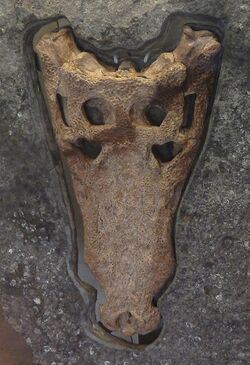Biology:Goniopholididae
| Goniopholididae | |
|---|---|

| |
| Amphicotylus milesi from the Late Jurassic of North America | |

| |
| Skull of Goniopholis | |
| Scientific classification | |
| Missing taxonomy template (fix): | Archosauria/Reptilia |
| Clade: | Pseudosuchia |
| Clade: | Crocodylomorpha |
| Clade: | Crocodyliformes |
| Clade: | Neosuchia |
| Family: | †Goniopholididae Cope, 1875 |
| Subgroups | |
Goniopholididae is an extinct family of moderate-sized semi-aquatic neosuchian crocodyliformes. Their bodyplan and morphology are convergent on living crocodilians. They lived across Laurasia (Asia, Europe and North America) between the Middle Jurassic (possibly Early Jurassic, see below) and the Late Cretaceous.
Description
The dorsal armour of goniopholidids is composed of two rows of paired osteoderms (as opposed to the four main pairs present in living crocodilians and other eusuchians), which are rectangular in shape and wider than they are long, with the lateral margins ventrally deflected and an anterior process for a ‘peg and groove’ articulation.[1] Unlike modern crocodilians they have ventral osteoderms as well. Their forelimbs are also proportionally very long, particularly in the humeri and wrist bones, being as long or longer than the hindlimbs, the opposite of the condition seen in modern crocodilians. Some like Anteophthalmosuchus also have forwardly oriented eyes, as opposed to the dorsally oriented eyes seen in modern forms. These suggest multiple biomechanical differences from modern species.[2][3]
Ecology
Goniopholidids likely had a similar ecology to modern crocodilians as semi-aquatic ambush predators.[4]
Evolutionary history
Goniopholidids have only been found in Laurasia (Asia, Europe and North America). The oldest possible member of the group is Calsoyasuchus from the Early Jurassic of North America.[5] However, its placement is disputed, with some studies recovering it as only distantly related to goniopholidids.[6][7] The goniopholidids were present across Eurasia during the Middle Jurassic[8][9] and were widespread in North America during the Late Jurassic[10] and continued to remain prominent across Laurasia during the Early Cretaceous.[4][11] Goniopolidids persisted into the late Upper Cretaceous in North America based on Denazinosuchus, from the Campanian-Maastrichtian of New Mexico, which is only known from fragmentary remains, and has been disputed as a member of the group, as well as remains of an unnamed goniopholidid from the Campanian aged Aguja Formation of Texas.[12]
Classification
The following cladogram simplified after an analysis presented by Marco Brandalise de Andrade and colleagues in 2011.[13]
| Neosuchia |
| ||||||||||||||||||||||||||||||||||||||||||||||||||||||||||||||||||||||||||||||||||||||||||||||||||||||||||||||||||||||||||||||||||||
References
- ↑ Puértolas-Pascual, E; Mateus, O (2020-06-11). "A three-dimensional skeleton of Goniopholididae from the Late Jurassic of Portugal: implications for the Crocodylomorpha bracing system". Zoological Journal of the Linnean Society 189 (2): 521–548. doi:10.1093/zoolinnean/zlz102. ISSN 0024-4082. https://doi.org/10.1093/zoolinnean/zlz102.
- ↑ Salisbury, S. W. & Frey, E. 2000. A biomechanical transformation model for the evolution of semi-spheroidal articulations between adjoining vertebral bodies in crocodilians. In Grigg, G. C., Seebacher, F. & Franklin, C. E. (eds) Crocodilian Biology and Evolution. Surry Beatty & Sons (Chipping Norton, Aus.), pp. 85-134.
- ↑ Salisbury, S. W. & Naish, D. (2011). Crocodilians. In Batten, D. J. (ed.) English Wealden Fossils. The Palaeontological Association (London), pp. 305-369.
- ↑ 4.0 4.1 Ristevski, Jorgo; Young, Mark T.; de Andrade, Marco Brandalise; Hastings, Alexander K. (April 2018). "A new species of Anteophthalmosuchus (Crocodylomorpha, Goniopholididae) from the Lower Cretaceous of the Isle of Wight, United Kingdom, and a review of the genus" (in en). Cretaceous Research 84: 340–383. doi:10.1016/j.cretres.2017.11.008. https://linkinghub.elsevier.com/retrieve/pii/S0195667117302136.
- ↑ Tykoski RS, Rowe TB, Ketcham RA, Colbert MW. 2002. Calsoyasuchus valliceps, a new crocodyliform from the Early Jurassic Kayenta Formation of Arizona. Journal of Vertebrate Paleontology 22 (3): 593-611.
- ↑ Ruebenstahl, Alexander A.; Klein, Michael D.; Yi, Hongyu; Xu, Xing; Clark, James M. (2022-06-14). "Anatomy and relationships of the early diverging Crocodylomorphs Junggarsuchus sloani and Dibothrosuchus elaphros" (in en). The Anatomical Record 305 (10): 2463–2556. doi:10.1002/ar.24949. ISSN 1932-8486. PMID 35699105.
- ↑ Wilberg, Eric W.; Turner, Alan H.; Brochu, Christopher A. (December 2019). "Evolutionary structure and timing of major habitat shifts in Crocodylomorpha" (in en). Scientific Reports 9 (1): 514. doi:10.1038/s41598-018-36795-1. ISSN 2045-2322. PMID 30679529.
- ↑ Panciroli, Elsa; Benson, Roger B. J.; Walsh, Stig; Butler, Richard J.; Castro, Tiago Andrade; Jones, Marc E. H.; Evans, Susan E. (2020-07-27). "Diverse vertebrate assemblage of the Kilmaluag Formation (Bathonian, Middle Jurassic) of Skye, Scotland". Earth and Environmental Science Transactions of the Royal Society of Edinburgh 111 (3): 135–156. doi:10.1017/s1755691020000055. ISSN 1755-6910. http://dx.doi.org/10.1017/s1755691020000055.
- ↑ Kuzmin, I.T.; Skutschas, P.P.; Grigorieva, O.I.; Krasnolutskii, S.A. (2013-12-30). "Goniopholidid crocodylomorph from the Middle Jurassic Berezovsk Quarry locality (Western Siberia, Russia)" (in ru). Proceedings of the Zoological Institute RAS 317 (4): 452–458. doi:10.31610/trudyzin/2013.317.4.452. ISSN 0206-0477. https://www.zin.ru/journals/trudyzin/eng/publication.html?id=181.
- ↑ Yoshida, Junki; Hori, Atsushi; Kobayashi, Yoshitsugu; Ryan, Michael J.; Takakuwa, Yuji; Hasegawa, Yoshikazu (December 2021). "A new goniopholidid from the Upper Jurassic Morrison Formation, USA: novel insight into aquatic adaptation toward modern crocodylians". Royal Society Open Science 8 (12): 210320. doi:10.1098/rsos.210320. ISSN 2054-5703. PMID 34909210. PMC 8652276. http://dx.doi.org/10.1098/rsos.210320.
- ↑ Lauprasert, Komsorn; Cuny, Gilles; Buffetaut, Eric; Suteethorn, Varavudh; Thirakhupt, Kumthorn (2007-05-01). "Siamosuchus phuphokensis, a new goniopholidid from the Early Cretaceous (ante-Aptian) of northeastern Thailand" (in en). Bulletin de la Société Géologique de France 178 (3): 201–216. doi:10.2113/gssgfbull.178.3.201. ISSN 1777-5817. https://pubs.geoscienceworld.org/sgf/bsgf/article/178/3/201/88480/Siamosuchus-phuphokensis-a-new-goniopholidid-from.
- ↑ Lehman, Thomas M.; Wick, Steven L.; Brink, Alyson A.; Shiller, Thomas A. (July 2019). "Stratigraphy and vertebrate fauna of the lower shale member of the Aguja Formation (lower Campanian) in West Texas" (in en). Cretaceous Research 99: 291–314. doi:10.1016/j.cretres.2019.02.028. https://linkinghub.elsevier.com/retrieve/pii/S0195667118304361.
- ↑ Marco Brandalise de Andrade; Richard Edmonds; Michael J. Benton; Remmert Schouten (2011). "A new Berriasian species of Goniopholis (Mesoeucrocodylia, Neosuchia) from England, and a review of the genus". Zoological Journal of the Linnean Society 163 (s1): S66–S108. doi:10.1111/j.1096-3642.2011.00709.x.
Wikidata ☰ Q140153 entry
 |

